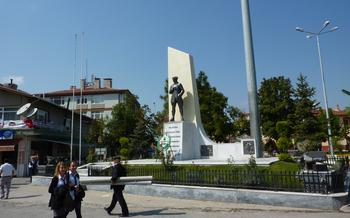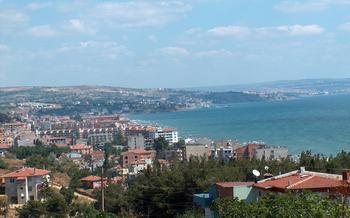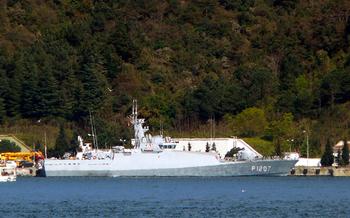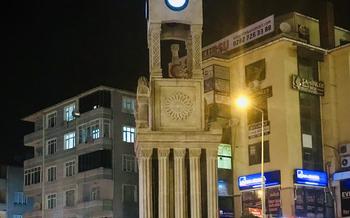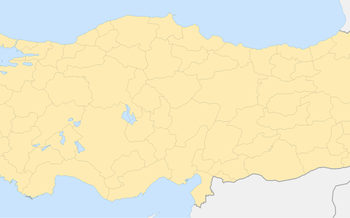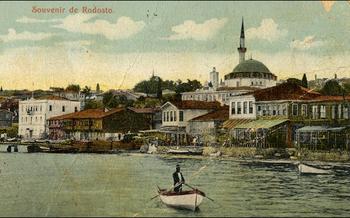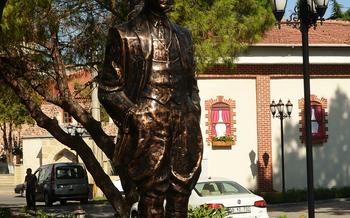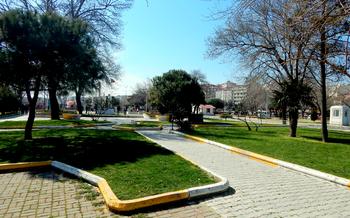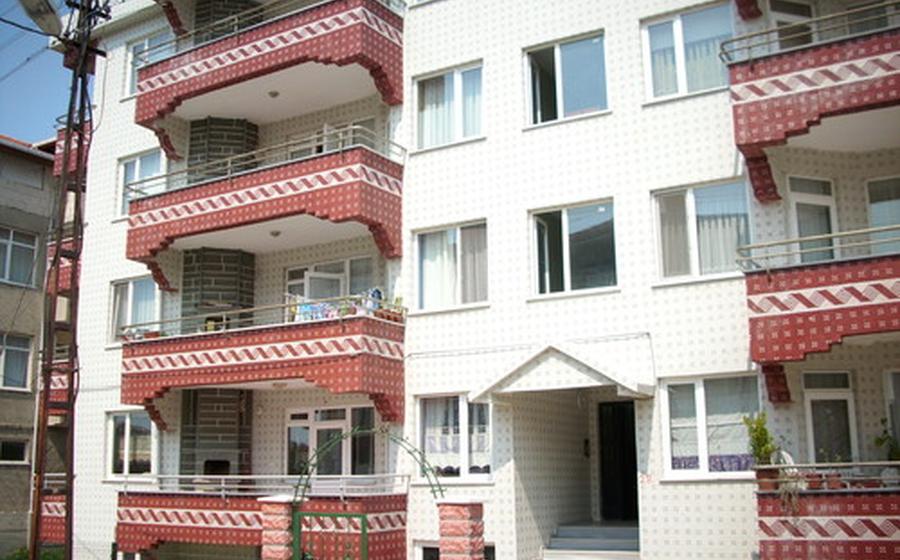
Muratlı Historical Watermill
- A Trip to the Past: Discovering the Muratlı Historical Watermill
- Location and Getting There
- Hours of Operation and Admission Fees
- Guided Tours and Self-Exploration
- Exploring the Watermill's Exterior
- Stepping Inside the Watermill
- The Watermill's Role in the Community
- Contribution to Local Cuisine
- Cultural Significance and Symbolism
- Events and Festivals
- Tips for a Memorable Visit
- Accessibility and Facilities
- Preservation and Conservation Efforts
- Insider Tip: Hidden Gems to Discover
A Trip to the Past: Discovering the Muratlı Historical Watermill
In the heart of Tekirdağ lies a testament to Turkey's rich cultural heritage - the Muratlı Historical Watermill. This ancient structure, with its imposing stone walls and intricate wooden mechanisms, invites visitors to step back in time and experience the ingenuity of our ancestors. Built centuries ago, the watermill stands as a symbol of human innovation and the vital role it played in sustaining communities.
As you approach the watermill, the gentle sound of flowing water fills the air, creating a sense of tranquility that envelops you. The architectural features of the mill, with its arched doorways, rustic wooden beams, and weathered stone walls, speak volumes about its enduring strength and resilience. In its heyday, the Muratlı Historical Watermill served as the lifeblood of the local community, providing sustenance and economic prosperity. Over the years, legends and stories have woven themselves around the watermill, adding an aura of mystery and enchantment to its already captivating presence.
Location and Getting There
The Muratlı Historical Watermill is nestled in the heart of the picturesque town of Muratlı, Tekirdağ, Turkey. To reach this hidden gem, travelers can embark on a scenic journey by car, bus, or train. For those driving, the watermill is conveniently located just off the main highway, with ample parking available nearby. Alternatively, visitors can opt for a leisurely bus ride from Tekirdağ city center, which offers regular services to Muratlı. Once in Muratlı, a short walk or a quick taxi ride will lead you to the doorstep of the historical watermill.
Upon arrival, visitors are greeted by the tranquil ambiance of the watermill's surroundings. The gentle murmur of the flowing water, the lush greenery, and the traditional architecture create a serene atmosphere that transports visitors back in time. Before delving into the watermill's fascinating history, take a moment to soak in the charm of its exterior and the natural beauty that envelops it.
Nearby attractions worth combining in your trip:
-
Süleymanpaşa Castle: Explore the remnants of this medieval fortress, which once played a crucial role in defending the region.
-
Tekirdağ Museum: Discover the rich cultural heritage of Tekirdağ through exhibits showcasing artifacts from various historical periods.
-
Ganos Mountain: Immerse yourself in nature's embrace by hiking through the scenic trails of Ganos Mountain, offering panoramic views of the region.
Hours of Operation and Admission Fees
The Muratlı Historical Watermill welcomes visitors all year round, providing a unique glimpse into the region's rich history. The current hours of operation are from 8:00 am to 6:00 pm, seven days a week. However, it's worth noting that these hours may vary during public holidays or special events. To ensure a smooth and enjoyable visit, it's advisable to check the official website or contact the local tourism office for any updates or seasonal changes in operating hours.
Admission fees for adults are set at a reasonable rate, while children and students can benefit from discounted prices. Family passes or group discounts may also be available, offering a cost-effective option for larger groups or families. It's worth considering purchasing a combined ticket that includes access to other nearby attractions or museums, as this can provide significant savings and enhance your overall experience in the region.
Guided Tours and Self-Exploration
For a more in-depth understanding of the Muratlı Historical Watermill's significance, guided tours are available in multiple languages. These tours typically cover the history, architecture, and operation of the watermill, providing insights into its role in the local community. The cost of guided tours varies based on the group size and language preference.
However, if you prefer to explore the watermill at your own pace, self-guided tours are equally rewarding. Embark on a journey of discovery, following a recommended route that takes you through the exterior and interior of the watermill. Immerse yourself in the ambiance, capture stunning photographs, and marvel at the ingenuity of the watermill's design. Embrace the opportunity to connect with the past as you uncover the stories and secrets held within these ancient walls.
Exploring the Watermill's Exterior
The exterior of the Muratlı Historical Watermill is a captivating blend of history and natural beauty. Its sturdy stone walls, weathered by time, tell tales of its enduring presence in the region. Take a moment to admire the intricate carvings and engravings adorning the exterior, which hint at the craftsmanship and artistry that went into its construction.
As you stroll around the watermill, don't miss the opportunity to capture some stunning photographs. The picturesque surroundings, with lush greenery and the gentle flow of the river, provide a perfect backdrop for your shots. Be sure to capture the watermill from different angles to showcase its unique features and the harmonious blend of nature and architecture.
Stepping Inside the Watermill
Venturing inside the Muratlı Historical Watermill is like stepping back in time. The interior layout showcases the intricate machinery and equipment used in the milling process, offering a glimpse into the ingenuity of past generations. The main attraction is the massive millstone, which once ground wheat and other grains into flour. Visitors can marvel at its impressive size and learn about the techniques used to operate it. Other notable features include the wooden gears, waterwheels, and various tools that played a crucial role in the milling process. Interactive exhibits and displays provide further insights into how the watermill functioned and the importance of its role in the community. The interior of the Muratlı Historical Watermill is a testament to the skill and craftsmanship of our ancestors, showcasing the harmonious blend of engineering and natural resources that sustained communities for centuries.
The Watermill's Role in the Community
The Muratlı Historical Watermill held a crucial position within the local community. It served as the backbone of the region's economy, providing essential services and products. Farmers would bring their grains to the mill to be ground into flour, which was then used to make bread and other food staples. This exchange not only ensured a steady supply of food for the community but also created employment opportunities and fostered economic growth.
Beyond its economic significance, the watermill played a vital role in shaping the social fabric of the community. It served as a gathering place for locals, who would come together to share stories, exchange news, and celebrate special occasions. The watermill also played a role in religious ceremonies and festivals, contributing to the region's rich cultural heritage.
Stories and anecdotes from locals reveal the deep connection between the watermill and the community. Elders recall how the mill was a hub of activity, with people from all walks of life coming together to witness the magic of grain transformation. The sound of the waterwheel and the smell of freshly ground flour filled the air, creating a vibrant and memorable atmosphere.
Contribution to Local Cuisine
The Muratlı Historical Watermill has played a significant role in shaping the culinary traditions of the region. The freshly ground flour produced by the watermill has been a staple ingredient in local kitchens for centuries. Traditional dishes like "köy ekmeği" (village bread), "gözleme" (a type of flatbread), and "mantı" (Turkish ravioli) rely on the high-quality flour from the watermill.
Visitors can find these local delicacies in nearby restaurants or even try their hand at cooking them during a culinary workshop or cooking class. The watermill's contribution to the local cuisine is a testament to its enduring legacy and the deep connection between the watermill and the community.
Cultural Significance and Symbolism
The Muratlı Historical Watermill holds deep cultural significance and serves as a symbol of traditional Turkish craftsmanship. Its intricate architecture and ingenious engineering represent the skill and artistry of the region's artisans. The watermill's enduring presence embodies the connection to the region's agricultural heritage, showcasing the importance of grain production and sustenance in the local community. Additionally, it serves as a reminder of the enduring customs and traditions associated with watermills, highlighting their role in preserving cultural identity and heritage. Whether viewed as a symbol of ingenuity, resilience, or continuity, the Muratlı Historical Watermill stands as a testament to the cultural richness and heritage of the Tekirdağ region.
Events and Festivals
The Muratlı Historical Watermill is not just a static museum; it comes alive during special events and festivals that celebrate the region's rich cultural heritage. One of the most popular events is the annual Watermill Festival, held in the summer months. This vibrant festival showcases traditional Turkish music, dance, and crafts, immersing visitors in the vibrant local culture.
During the festival, the watermill's grounds transform into a lively marketplace, where artisans display their handmade goods, from intricate pottery to colorful textiles. Visitors can savor delicious local delicacies prepared using the watermill's freshly ground flour, while enjoying live performances and demonstrations of traditional crafts.
The Watermill Festival is a fantastic opportunity to experience Turkish hospitality and learn about the region's history and traditions. It's a chance to immerse yourself in the vibrant local culture and make memories that will last a lifetime. Be sure to check the festival's official website or local tourism offices for dates and details of upcoming events.
Tips for a Memorable Visit
To make the most of your visit to the Muratlı Historical Watermill and ensure a memorable experience, consider the following tips:
-
Plan Your Timing: Aim to visit the watermill during the morning or late afternoon to avoid the midday heat. The best time to capture stunning photographs of the watermill and its surroundings is during the golden hours of sunrise or sunset.
-
Duration of Visit: Allocate at least one to two hours for your visit to explore the watermill's exterior, step inside to learn about its history and operation, and take a leisurely stroll around the scenic grounds.
-
Comfortable Footwear: Wear comfortable walking shoes or sneakers, as you may encounter uneven terrain and steps during your exploration.
-
Essential Packing: Carry a water bottle to stay hydrated, especially during hot weather. Consider bringing a hat or sunglasses for protection from the sun. A camera is a must to capture the picturesque landscapes and historical charm of the watermill.
Accessibility and Facilities
The Muratlı Historical Watermill has been carefully designed to accommodate visitors with diverse needs. Wheelchair ramps and designated pathways ensure that individuals with mobility challenges can comfortably explore the site. Restrooms are available for public use, and seating areas are strategically placed throughout the watermill, providing opportunities for visitors to rest and soak in the ambiance. Fresh drinking water is accessible at various points, ensuring hydration during your exploration.
Ample parking facilities are available near the watermill, with designated spaces for cars, buses, and bicycles. Parking fees are minimal and contribute to the maintenance and upkeep of the site. The watermill welcomes responsible pet owners to bring their furry companions along, but pets must be kept on a leash and under control at all times.
Preservation and Conservation Efforts
The Muratlı Historical Watermill stands as a testament to the resilience of cultural heritage and the dedication of preservationists. Ongoing efforts are underway to ensure that this historic gem remains a source of pride for generations to come. Visitors play a crucial role in supporting these conservation initiatives through their visits and contributions. Tourism revenue directly supports the maintenance and upkeep of the watermill, allowing for necessary repairs and renovations.
By choosing to visit the Muratlı Historical Watermill, you become a part of the preservation process. Your presence and appreciation help raise awareness for the importance of preserving cultural heritage sites like this one. You also contribute to the local economy, which in turn supports the community's efforts to maintain and protect the watermill.
One way to further contribute to conservation efforts is to take part in guided tours offered by the watermill. These tours often provide valuable insights into the history, significance, and preservation challenges faced by the site. By engaging with the knowledgeable guides, you gain a deeper understanding of the importance of preserving cultural heritage and the role you play in its sustainability.
Insider Tip: Hidden Gems to Discover
Beyond the main attractions of the Muratlı Historical Watermill, there are hidden gems waiting to be discovered by curious travelers. One such gem is the secluded garden located behind the watermill. This tranquil oasis offers a serene escape from the hustle and bustle of the mill, with lush greenery, colorful flowers, and a charming fountain. Visitors can relax on the benches beneath the shade of the trees and enjoy a moment of peace and tranquility.
Another hidden gem is the old miller's house, which is situated a short walk from the watermill. This quaint cottage provides a glimpse into the life of the miller and his family. Inside, visitors can see the traditional furnishings, tools, and equipment that were used in the past. The miller's house offers a unique opportunity to learn about the history of the watermill and the people who worked there.
For those interested in capturing unique photos, there are several secret spots around the watermill that offer stunning views. One such spot is the top of the watermill, which provides a panoramic vista of the surrounding countryside. Another great spot is the nearby riverbank, where visitors can capture the reflection of the watermill in the water.
These hidden gems add an extra layer of charm and intrigue to the Muratlı Historical Watermill. By exploring these lesser-known areas, visitors can gain a deeper appreciation for the watermill's history, culture, and natural beauty.
